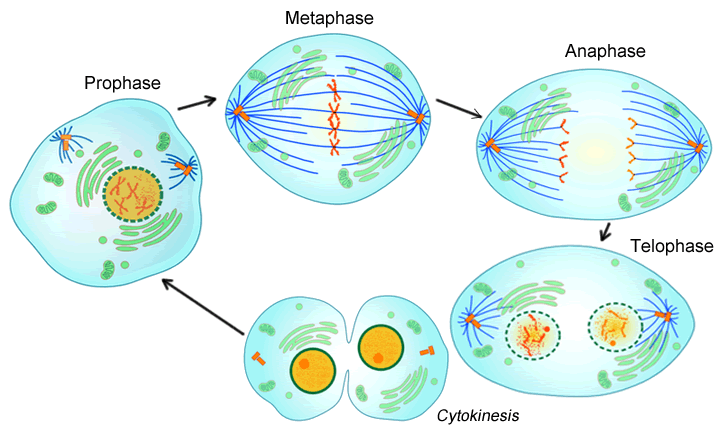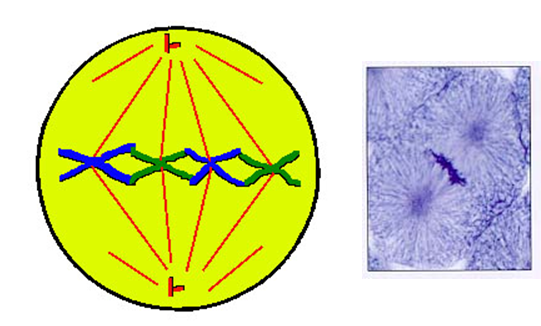

Homologous chromosomes can exchange parts in a process called "crossing over. prophase anaphase metaphase telophase prophase Early in mitosis, the nucleus, nucleolus, and nuclear envelope begin to dissolve in preparation for cell division. In Metaphase I, homologous chromosome pairs line up. This shuffling process is known as recombination or "crossing over" and occurs while the chromome pairs are lined up in Metaphase I. Each sibling is 50% mom and 50% dad, but which 50% of each can vary in the siblings. But this happens independently for each trait, so just because you got your dad's brown eyes doesn't mean you'll get his blond hair too. Each sperm and egg will end up with either B or b from mom and either B or b from dad. Mitosis steps consist of prophase, metaphase, anaphase, and telophase the cell undergoes nucleus division and split into two identical daughter cells.

This leads to four possibilities: You could get B from mom and B from dad, or B from mom and b from dad, or b from mom and B from dad, or b from mom and b from dad. Imagine, for example, that eye color was controlled by a single gene, and that mom could have B, the allele for brown eyes or b, the allele for blue eyes, and dad could also have B or b. But each non-identical-twin child of these parents ends up with a different combination. You ended up with half of mom's paired genes and half of dad's paired genes. Four genetically unique daughter cells are produced.Your parents each have at least one pair of alleles (versions of a gene) for every trait (and many pairs of alleles for each polygenic trait). Nuclear envelope reforms and cytokinesis takes places. Telophase II: chromatids reach opposite poles of the cell. Metaphase II: chromosomes attach to the spindle fibre by their centromeres.Īnaphase II: sister chromatids are separated. Prophase II: chromosomes condense, nuclear envelope disintegrates and spindle fibres form. Cytokinesis results in the formation of two daughter cells. Nuclear envelope reforms around the chromosomes. Telophase I: chromosomes reach opposite poles of the cell. Metaphase I: homologous chromosomes line up along the equator and attach to the spindle fibre by their centromeres.Īnaphase I: homologous chromosomes are separated The nuclear envelope disintegrates and spindle fibres form. Prophase I: chromatids condense and arrange themselves into homologous pairs (called bivalents).

Interphase: the DNA replicates so there are now two identical copies of each chromosome (referred to as chromatids). As positioning of bivalent pairs is random, assortment of maternal and paternal chromosomes in each telophase nucleus is also random. Meiosis involves two rounds of cell division which are referred to as meiosis I and meiosis II. Anaphase and telophase I Anaphase I of meiosis begins with the release of cohesion between the arms of sister chromatids, much as it does during mitosis. When two haploid gametes join during fertilisation, a diploid cell called a zygote is formed. Unlike mitosis, the daughter cells are genetically different from the parent cell and contain just half the number of chromosomes (i.e. Meiosis is the type of cell division which produces gametes for sexual reproduction. Prophase II: During this phase, the nuclear envelope breaks down, and spindle fibers form from the centrioles at opposite poles of the cell. The cytoplasm divides ( cytokinesis) and the plasma membrane pinches off to form two new, genetically-identical cells. Telophase & cytokinesis - the two groups of chromsomes decondense (they become long and thin) and a nuclear envelope reforms around them, forming two new nuclei. They attach to the spindle fibre by their centromere.Īnaphase - the centromere splits and the chromatids are pulled to opposite poles of the cell. Metaphase - the chromosomes line up along the middle of the cell. The centrioles move to opposite poles of the cell and form spindle fibres. Prophase - the chromosomes condense (they become shorter and fatter) and the nuclear envelope disintegrates. The mitochondria produce more ATP which will provide the energy for cell division. Once the DNA has replicated, each chromosome now consists of two sister chromatids, connected by a structure called the centromere. Interphase - the cell prepares for mitosis by growing larger, replicating its organelles and synthesising new DNA (see above).


 0 kommentar(er)
0 kommentar(er)
